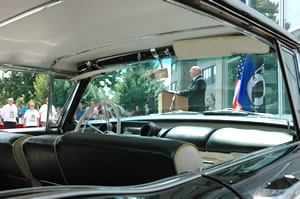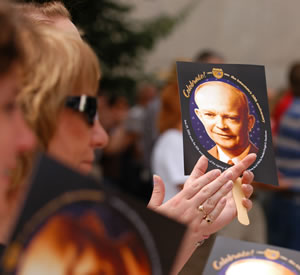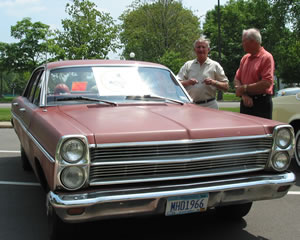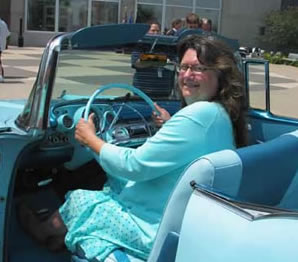By Craig Wilkins

Framed by the windshield of a 1957 Mercury Turnpike Cruiser, former Commissioner Dick Braun spoke during the 50th interstate highway system anniversary celebration. He served as commissioner from 1979 until 1986. Photo by David Gonzalez |
They ranged from truck tractors to a startlingly turquoise ’59 Cadillac to a very plain 1966 Ford sedan that once belonged to Mn/DOT’s vehicle fleet. Some of the vehicles rumbled deeply; others burbled as their drivers eased them into their parking spots.
The arrival of the vintage cars, a shiny row of chevrons along a sleeve of asphalt, marked the start of the June 29 celebration of the 50th anniversary of the interstate highway system.
The day also recognized Mn/DOT’s role in creating the system and honored three current employees whose careers had already started when President Dwight D. Eisenhower signed the Federal Aid Highway Act on June 29, 1956.
The celebration at the Transportation Building in St. Paul continued with music from the 1950s and 1960s, displays about the system’s history and remarks by transportation leaders.

A participant at the celebration cooled herself with a fan featuring a photo of President Dwight D. Eisenhower. Eisenhower signed the 1956 Federal-Aid Highway Act that created the interstate system. Photo by David Gonzalez |
Tom Sorel, Federal Highway Administration regional administrator for Minnesota, said the interstate highway system might be considered the greatest public works project in the nation’s history.
The interstate system comprises just more than one percent of the nation’s roads, Sorel said, yet carries nearly 25 of total vehicle travel, including 40 percent of total truck miles.
“The interstates are so much a part of daily life that most of us do not realize that the system we often use to get to work, school, the mall and for vacation trips is one of the ‘wonders of the world,’” he said.
Lt. Gov./Commissioner Carol Molnau sounded a similar theme in her remarks.
“Building the interstate highway system has shaped our state and our country,” she said. “Interstate highways are critical links between urban and rural areas and make it easier for us all to connect with family, goods and services, education and recreation.”

Retirees Dick Hathaway (at left) and Wayne Murphy take a close look at a former Mn/DOT fleet car, a 1966 Ford, and its license plate, MHD1966. Enrico Sherman, Land Management, owns the car. The car is now covered in primer; Sherman plans to paint it black, the same color used by the former Minnesota Highway Department for sedans, pickups and panel trucks. Photo by Kent Barnard |
She cited examples of continuing innovation on Minnesota’s interstates such as the Minnesota Road Research Project that uses a three-mile section of Interstate 94 to test various pavement designs and vehicle tolling on I-394 in the Twin Cities metro area to better use excess capacity on the freeway’s high-occupancy vehicle lanes.
Dick Braun, a former commissioner who was extensively involved in planning and building the system, recounted the many problems and pitfalls and eventual triumphs experienced during its construction.
Braun also led the recognition of three current employees whose careers were already under way when the interstate system began: George Thibault, Office of Freight and Commercial Vehicle Operations, and Jack Pirkl and Darlene Lazer from the Metro District.
“This trio of employees has worked in the transportation field since the dawn of the interstate system,” he said. “Their careers began with the system’s start in Minnesota and paralleled its design and construction. Now, they share in shaping innovations under way to improve its longevity and capacity,” he said.

Teresa Chapman, Investment Management, found a display car that matched her outfit—a 1957 Chevrolet Bel Air convertible. Photo by Teresa Callies |
Minnesota’s observance was part of a national celebration of the interstate highway system’s beginning.
See also:
|



